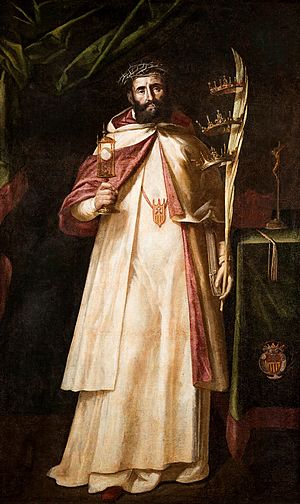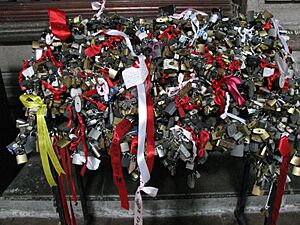Raymond Nonnatus facts for kids
Quick facts for kids SaintRaymond Nonnatus O. de M. |
|
|---|---|

Saint Raymond Nonnatus
by Antonio del Castillo y Saavedra, 1640 |
|
| Religious, priest and confessor | |
| Born | 1204 Portell, County of Segarra, Principality of Catalonia, Crown of Aragon, (current Spain) |
| Died | August 31, 1240 Castle of Cardona, County of Cardona, Principality of Catalonia, Crown of Aragon, (current Spain) |
| Venerated in | Roman Catholic Church |
| Canonized | 1657, Rome, by Pope Alexander VII |
| Feast | August 31 |
| Attributes | A Mercedarian friar wearing a cardinal's red mozzetta, holding a monstrance and a martyr's palm branch |
| Patronage | Baitoa, Dominican Republic; Moncada, Tarlac; childbirth; expectant mothers; pregnant women; newborn babies; infants; children; obstetricians; midwives; fever; the falsely accused; confidentiality of confession |
Saint Raymond Nonnatus (born 1204, died August 31, 1240) was a important saint from Catalonia, a region in Spain. His unique nickname, "Nonnatus," means "not born." This name comes from the way he was born: his mother died during childbirth, and he was saved through a special surgery called a Caesarean section.
Raymond is known as the patron saint for many people and situations. He is especially honored by those involved in childbirth, like midwives and expectant mothers. He is also a saint for children, newborn babies, and priests who keep the secrets of confession.
Contents
Raymond's Early Life
Raymond Nonnatus was born in a village called Portell, which is now part of Sant Ramon. He was taken from his mother's womb after she passed away, which is how he got his name. Some stories say he was the son of a local count, who might have even performed the surgery that saved Raymond's life. Other stories suggest he came from a family of shepherds.
Raymond's father wanted him to have a career at the royal court of the Kingdom of Aragon. However, Raymond felt called to a religious life. His father tried to make him manage a family farm instead. But Raymond spent his childhood looking after sheep and often prayed at a small, old chapel nearby. This chapel was dedicated to St. Nicholas. Eventually, his father allowed him to follow his religious path.
Joining the Mercedarian Order
Raymond was allowed to join the Mercedarians in Barcelona. This religious order had a very special mission: to free Christian captives who were held by the Moors in North Africa. Raymond was taught by the founder of the order himself, St. Peter Nolasco.
Raymond became a priest in 1222. Later, he rose to a high position, becoming a leader within the Mercedarian Order.
Helping Captives in North Africa
Raymond dedicated his life to the order's goal of freeing captives.
- He first went to Valencia, where he helped free 140 Christians from slavery.
- Then, he traveled to North Africa. In Algiers, he managed to free another 250 captives.
- He continued to Tunis. When he ran out of money, he offered himself as a hostage to free 28 more Christians. This was part of a special promise (a "fourth vow") that Mercedarian members made.
While in captivity, Raymond suffered greatly. A story says that his captors made a hole through his lips with a hot iron and put a padlock on his mouth. They did this to stop him from preaching about his faith. Eventually, his order paid to free him, and he returned to Spain in 1239.
Death and Burial
Raymond died at the Castle of Cardona, about 60 miles from Barcelona. He passed away on August 31, 1240. After his death, there was a disagreement about where he should be buried. The local count, the friars, and the town all wanted his body.
To solve this problem, his body was placed on a blind mule, which was then set free. The mule, without anyone guiding it, walked to the old country chapel where Raymond used to pray when he was young. This is where he was buried. Many amazing things were said to have happened because of him, both before and after his death.
Becoming a Saint
Raymond was officially made a saint by Pope Alexander VII in 1657. His feast day, which is a special day to remember him, is celebrated every year on August 31.
For a long time, people believed that Pope Gregory IX had made Raymond a cardinal (a high-ranking official in the Catholic Church) in 1239. Because of this, he is often shown wearing the red robes of a cardinal. However, historians have found that this was likely a mistake, and Raymond was probably never a cardinal.
Honoring Saint Raymond
Many places around the world are named after Saint Raymond Nonnatus.
- In Canada, there is Saint-Raymond, Quebec.
- In Argentina, you can find San Ramón de la Nueva Orán.
- Brazil has São Raimundo Nonato.
- San Ramón is in Costa Rica.
There are also churches and dioceses (areas led by a bishop) dedicated to him.
- In the United States, the Parish of St. Raymond is in the Bronx, New York City.
- The Cathedral of St. Raymond Nonnatus is in Joliet, Illinois.
- There are also St. Raymond parishes in Raymond, Illinois, and Downey, California.
- In Juana Díaz, Puerto Rico, there is a parish dedicated to him too.
Because of the story of his own birth, Saint Raymond quickly became a popular saint for women who were about to give birth.
A special tradition involves placing locks at his altar. These locks represent a prayer asking for help to stop gossip, rumors, false accusations, and other harmful uses of the tongue. The locks are a visible sign of this prayer, which is first and foremost a request to God through Saint Raymond's help.
What He Looks Like in Art
In pictures and statues, Saint Raymond is often shown wearing the clothes of his order. He is usually surrounded by people he helped free from captivity. Sometimes, he is shown with a padlock on his lips, remembering the suffering he endured.
See also
 In Spanish: Ramón Nonato para niños
In Spanish: Ramón Nonato para niños


